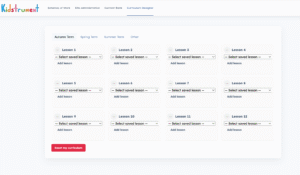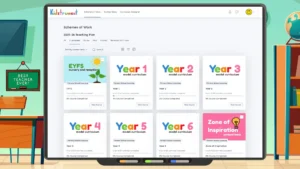Many primary teachers admit they don’t feel confident teaching music. Some worry about their own singing voice, others about not being able to read notation. The good news? You don’t need to be a musician to deliver fun, engaging, and curriculum-aligned music lessons.
With the right approach and resources, any teacher can help children develop their musical skills.
Start with Singing
Singing is the most accessible starting point for every class. You don’t need instruments, and children respond well to it. Choose simple songs with repetition, echoes, or rounds. Don’t worry about sounding like a professional—what matters is modelling confidence.
Tip: Warm up with call-and-response patterns. For example, clap or sing a short phrase and have the class copy. This builds pulse, rhythm, and focus.
Use Rhythm Games and Body Percussion
Clapping, stamping, and tapping on the desk are powerful tools for teaching rhythm. They need no equipment, and they make learning fun. Try:
- Passing a clap around the circle to keep the pulse.
- Creating short rhythm patterns for the class to echo.
- Splitting the class into groups for layered rhythms.
These games develop timing and teamwork without needing specialist knowledge.
Keep Instruments Simple
If your school has percussion, start there. Triangles, tambourines, drums, and shakers are easy to manage. Tuned instruments like glockenspiels or keyboards can come later, but even with untuned percussion, children can explore dynamics, tempo, and texture.
Tip: Set clear rules before handing out instruments—e.g. “hold still until the signal.” That saves chaos!
Build Confidence with Structured Activities
The hardest part for non-specialist teachers is often planning. What should come next? How do you know if children are progressing? This is where structured schemes and resources make a difference.
For example, Kidstrument includes over 600 ready-to-teach activities, all mapped to curriculum outcomes. That means you can pick an activity and deliver it straight away, without worrying if it’s age-appropriate or linked to the right skills.
Focus on Progress, Not Perfection
Children don’t need to perform like trained musicians. What matters is that they:
- Keep a pulse.
- Sing tunefully with increasing confidence.
- Experiment with creating sounds.
- Begin to use musical vocabulary.
Celebrate small steps. If a child who was shy about singing joins in with one phrase, that’s real progress.
Make It Interactive
Music lessons work best when pupils are active. Avoid too much teacher talk. Instead, get children clapping, moving, and listening. Short bursts of activity keep the pace up and the energy positive.
Tip: Use recorded music for listening tasks. Ask children to respond with drawings, movements, or words to describe what they hear.
Let Digital Tools Do the Heavy Lifting
Non-specialists often need reassurance that they’re “doing it right.” Kidstrument gives you that structure:
- Activities that match the national curriculum and model music curriculum.
- A built-in progression framework so you know exactly what to teach.
- Assessment tools that track outcomes automatically.
It’s like having a music specialist in your pocket, guiding you through every lesson.
Teaching music without being a specialist isn’t about faking expertise—it’s about creating joyful, structured opportunities for children to explore sound, rhythm, and creativity. With simple strategies and the right support, every teacher can make music a highlight of the week.
Want to see how Kidstrument helps non-specialist teachers deliver music with confidence?
Book a free demo today





